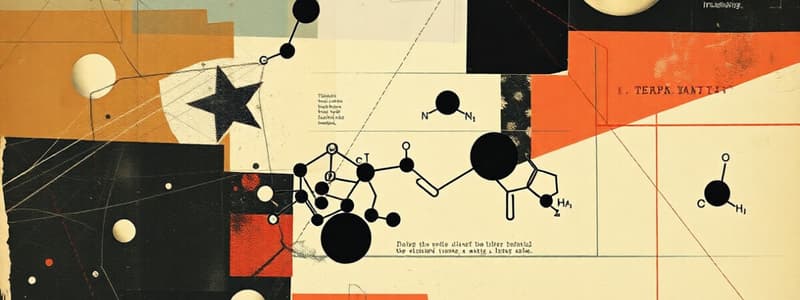Podcast
Questions and Answers
What are functional groups in organic chemistry typically responsible for?
What are functional groups in organic chemistry typically responsible for?
- Setting the molecular weight
- Determining the color of the compound
- Determining the chemical properties of the compound (correct)
- Increasing the melting point
Which of these categories does not belong to hydrocarbons?
Which of these categories does not belong to hydrocarbons?
- Alkynes
- Alkyls (correct)
- Alkanes
- Alkenes
What type of isomers have the same molecular formula but different connectivity of atoms?
What type of isomers have the same molecular formula but different connectivity of atoms?
- Geometric isomers
- Structural isomers (correct)
- Stereoisomers
- Constitutional isomers
Which statement correctly describes coordination chemistry?
Which statement correctly describes coordination chemistry?
According to the Brønsted-Lowry theory, what defines a base?
According to the Brønsted-Lowry theory, what defines a base?
What does thermodynamics study in relation to chemical systems?
What does thermodynamics study in relation to chemical systems?
Which phenomenon does not occur at chemical equilibrium?
Which phenomenon does not occur at chemical equilibrium?
In quantum chemistry, what is primarily studied to understand molecular systems?
In quantum chemistry, what is primarily studied to understand molecular systems?
Flashcards are hidden until you start studying
Study Notes
Organic Chemistry
- Definition: The study of carbon-containing compounds and their properties, structures, and reactions.
- Key Concepts:
- Functional Groups: Specific groups of atoms within molecules that determine chemical properties (e.g., hydroxyl, carboxyl, amino).
- Hydrocarbons: Compounds composed of hydrogen and carbon; categorized into alkanes, alkenes, and alkynes.
- Isomerism: The occurrence of compounds with the same molecular formula but different structures/properties (e.g., structural isomers, stereoisomers).
- Reactions: Common types include substitution, addition, elimination, and rearrangement.
- Biomolecules:
- Carbohydrates: Sugars and starches that provide energy.
- Proteins: Amino acid chains critical for biological functions.
- Lipids: Fatty acids and derivatives important for cell membranes.
- Nucleic Acids: DNA and RNA, essential for genetic information.
Inorganic Chemistry
- Definition: The study of inorganic compounds, excluding organic compounds primarily made of carbon.
- Key Concepts:
- Elements & Compounds: Focus mainly on metals, minerals, and coordination compounds.
- Coordination Chemistry: Study of complex ions formed between transition metals and ligands.
- Acids & Bases:
- Brønsted-Lowry Theory: Acids are proton donors and bases are proton acceptors.
- Lewis Theory: Acids are electron pair acceptors and bases are electron pair donors.
- Oxidation-Reduction Reactions: Reactions involving the transfer of electrons; oxidation involves losing electrons while reduction involves gaining them.
- Applications: Catalysts, fertilizers, pigments, and materials like ceramics and semiconductors.
Physical Chemistry
- Definition: The branch of chemistry that deals with the physical and chemical properties of substances and the energy changes associated with chemical reactions.
- Key Concepts:
- Thermodynamics: Study of energy, heat, and work in chemical systems; includes laws of thermodynamics.
- Kinetics: The study of the rates of chemical reactions and the factors affecting them; involves reaction mechanisms.
- Quantum Chemistry: Application of quantum mechanics to molecular systems, including electron configurations and wave functions.
- Chemical Equilibrium: The state where the forward and reverse reaction rates are equal, and concentrations of reactants/products remain constant.
- Techniques: Use of spectroscopy, chromatography, and other methods to analyze substance properties and behaviors.
Organic Chemistry
- Definition: The study of carbon-containing compounds, their properties, structures, and reactions.
- Functional Groups: Specific atomic groupings within molecules determining chemical properties (e.g., hydroxyl for alcohols, carboxyl for carboxylic acids, amino for amines).
- Hydrocarbons: Compounds composed solely of hydrogen and carbon, categorized into:
- Alkanes: Saturated hydrocarbons with single bonds (e.g., methane, ethane).
- Alkenes: Unsaturated hydrocarbons with at least one double bond (e.g., ethene).
- Alkynes: Unsaturated hydrocarbons with at least one triple bond (e.g., ethyne).
- Isomerism: Compounds sharing the same molecular formula but differing in structure or spatial arrangement, leading to varying properties.
- Structural Isomers: Differ in the arrangement of atoms within the molecule.
- Stereoisomers: Have the same connectivity but differ in spatial orientation (e.g., cis-trans isomers, enantiomers).
- Reactions: Common types include:
- Substitution: An atom or group is replaced by another.
- Addition: Atoms are added across a double or triple bond.
- Elimination: Atoms are removed from a molecule, forming a double or triple bond.
- Rearrangement: The atoms within a molecule are rearranged.
- Biomolecules: Essential for life, including:
- Carbohydrates: Sugars and starches, providing energy.
- Proteins: Chains of amino acids, crucial for various biological functions.
- Lipids: Fatty acids and derivatives, essential for cell membranes and energy storage.
- Nucleic Acids: DNA and RNA, responsible for genetic information storage and transfer.
Inorganic Chemistry
- Definition: The study of compounds excluding organic compounds primarily composed of carbon.
- Elements & Compounds: Focus on metals, minerals, and coordination compounds.
- Coordination Chemistry: Study of complex ions formed by transition metals with ligands (atoms or molecules bound to the metal center).
- Acids & Bases: Defined by different theories:
- Brønsted-Lowry Theory: Acids donate protons (H+), bases accept protons.
- Lewis Theory: Acids accept electron pairs, bases donate electron pairs.
- Oxidation-Reduction Reactions (Redox Reactions): Transfer of electrons:
- Oxidation: Loss of electrons.
- Reduction: Gain of electrons.
- Applications: Inorganic chemistry has wide applications, including:
- Catalysts: Speed up chemical reactions.
- Fertilizers: Enhance soil fertility.
- Pigments: Provide color in paints and dyes.
- Materials: Ceramics, semiconductors, and other materials with specific properties.
Physical Chemistry
- Definition: Focuses on the physical and chemical properties of substances and energy changes in chemical reactions.
- Key Concepts:
- Thermodynamics: Studies energy, heat, and work in chemical systems; includes laws of thermodynamics defining energy conservation and direction of reactions.
- Kinetics: Studies the rates of reactions and factors influencing them; includes reaction mechanisms, explaining how reactions proceed step-by-step.
- Quantum Chemistry: Applies quantum mechanics to molecular systems, explaining electron configurations and chemical bonding.
- Chemical Equilibrium: A dynamic state where forward and reverse reaction rates are equal, leading to constant reactant/product concentrations.
- Techniques: Physical chemistry utilizes:
- Spectroscopy: Analyze substances by their interactions with electromagnetic radiation.
- Chromatography: Separates and analyzes mixtures based on components' properties.
- Other methods: Exploring substance properties and behaviors.
Studying That Suits You
Use AI to generate personalized quizzes and flashcards to suit your learning preferences.




